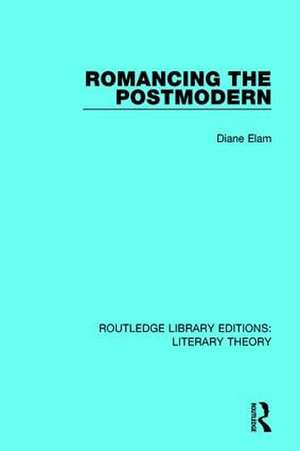Romancing the Postmodern
Autor Diane Elamen Limba Engleză Paperback – 9 ian 2018
Arguing for a parallel between postmodernism’s divided relation to modernism and romance’s difficult stance towards realism, Romancing the Postmodern, first published in 1992, not only highlights how postmodernism questions our assumptions about historical time, it also reintroduces the figure of woman to the theory of both history and literature.
| Toate formatele și edițiile | Preț | Express |
|---|---|---|
| Paperback (1) | 238.21 lei 6-8 săpt. | |
| Taylor & Francis – 9 ian 2018 | 238.21 lei 6-8 săpt. | |
| Hardback (1) | 669.94 lei 6-8 săpt. | |
| Taylor & Francis – 5 aug 2016 | 669.94 lei 6-8 săpt. |
Preț: 238.21 lei
Nou
Puncte Express: 357
Preț estimativ în valută:
45.58€ • 47.50$ • 37.74£
45.58€ • 47.50$ • 37.74£
Carte tipărită la comandă
Livrare economică 03-17 aprilie
Preluare comenzi: 021 569.72.76
Specificații
ISBN-13: 9781138685475
ISBN-10: 113868547X
Pagini: 218
Dimensiuni: 156 x 234 x 12 mm
Greutate: 0.29 kg
Ediția:1
Editura: Taylor & Francis
Colecția Routledge
Locul publicării:Oxford, United Kingdom
ISBN-10: 113868547X
Pagini: 218
Dimensiuni: 156 x 234 x 12 mm
Greutate: 0.29 kg
Ediția:1
Editura: Taylor & Francis
Colecția Routledge
Locul publicării:Oxford, United Kingdom
Public țintă
General, Postgraduate, and UndergraduateCuprins
Acknowledgements; Introduction: A Preface Which Should Have Been a Postscript; 1. P. S. "I Love You": Umberto Eco and the Romance of the Reader 2. Delayed in the Post: Walter Scott and the Progress of Romance 3. Romantic Letters and Postmodern Envelopes: Joseph Conrad and the Imperialism of Historical Representation 4. Heroines and Hero Worship: Walter Scott’s Uncertain Women and George Eliot’s Uncertain Romance 5. A Postscript Which Should Have Been a Preface: Theory’s Romance; Notes; Index
Descriere
By exposing the theory of romance to the romance of theory, Diane Elam explores literature’s most uncertain, least easily definable and most tenacious genre, assessing its implications for both feminism and the understanding of history.
Arguing for a parallel between postmodernism’s divided relation to modernism and romance’s difficult stance towards realism, Romancing the Postmodern, first published in 1992, not only highlights how postmodernism questions our assumptions about historical time, it also reintroduces the figure of woman to the theory of both history and literature.
Arguing for a parallel between postmodernism’s divided relation to modernism and romance’s difficult stance towards realism, Romancing the Postmodern, first published in 1992, not only highlights how postmodernism questions our assumptions about historical time, it also reintroduces the figure of woman to the theory of both history and literature.
